brake fluid JEEP GRAND CHEROKEE 2016 WK2 / 4.G User Guide
[x] Cancel search | Manufacturer: JEEP, Model Year: 2016, Model line: GRAND CHEROKEE, Model: JEEP GRAND CHEROKEE 2016 WK2 / 4.GPages: 276, PDF Size: 10.84 MB
Page 192 of 276
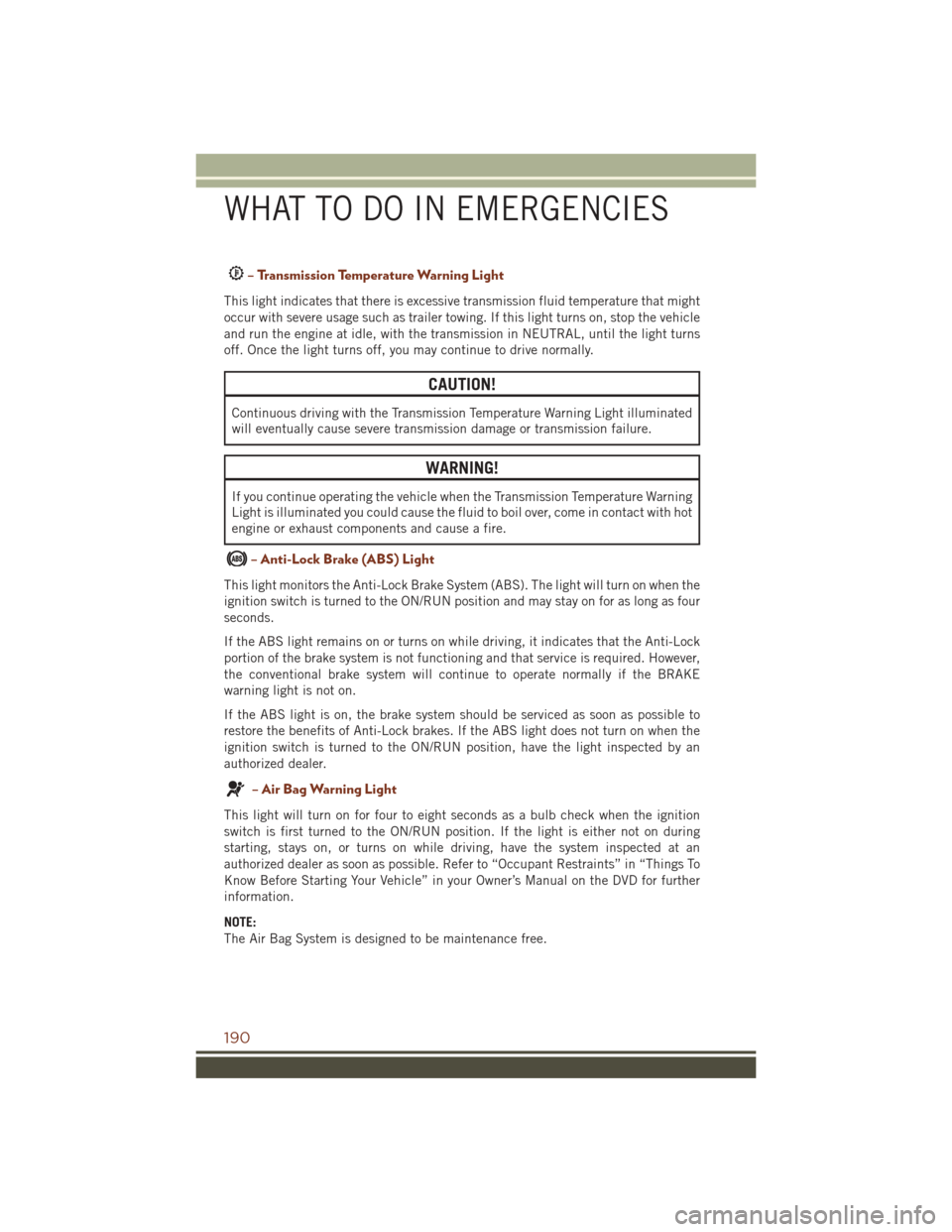
– Transmission Temperature Warning Light
This light indicates that there is excessive transmission fluid temperature that might
occur with severe usage such as trailer towing. If this light turns on, stop the vehicle
and run the engine at idle, with the transmission in NEUTRAL, until the light turns
off. Once the light turns off, you may continue to drive normally.
CAUTION!
Continuous driving with the Transmission Temperature Warning Light illuminated
will eventually cause severe transmission damage or transmission failure.
WARNING!
If you continue operating the vehicle when the Transmission Temperature Warning
Light is illuminated you could cause the fluid to boil over, come in contact with hot
engine or exhaust components and cause a fire.
– Anti-Lock Brake (ABS) Light
This light monitors the Anti-Lock Brake System (ABS). The light will turn on when the
ignition switch is turned to the ON/RUN position and may stay on for as long as four
seconds.
If the ABS light remains on or turns on while driving, it indicates that the Anti-Lock
portion of the brake system is not functioning and that service is required. However,
the conventional brake system will continue to operate normally if the BRAKE
warning light is not on.
If the ABS light is on, the brake system should be serviced as soon as possible to
restore the benefits of Anti-Lock brakes. If the ABS light does not turn on when the
ignition switch is turned to the ON/RUN position, have the light inspected by an
authorized dealer.
– Air Bag Warning Light
This light will turn on for four to eight seconds as a bulb check when the ignition
switch is first turned to the ON/RUN position. If the light is either not on during
starting, stays on, or turns on while driving, have the system inspected at an
authorized dealer as soon as possible. Refer to “Occupant Restraints” in “Things To
Know Before Starting Your Vehicle” in your Owner’s Manual on the DVD for further
information.
NOTE:
The Air Bag System is designed to be maintenance free.
WHAT TO DO IN EMERGENCIES
190
Page 195 of 276
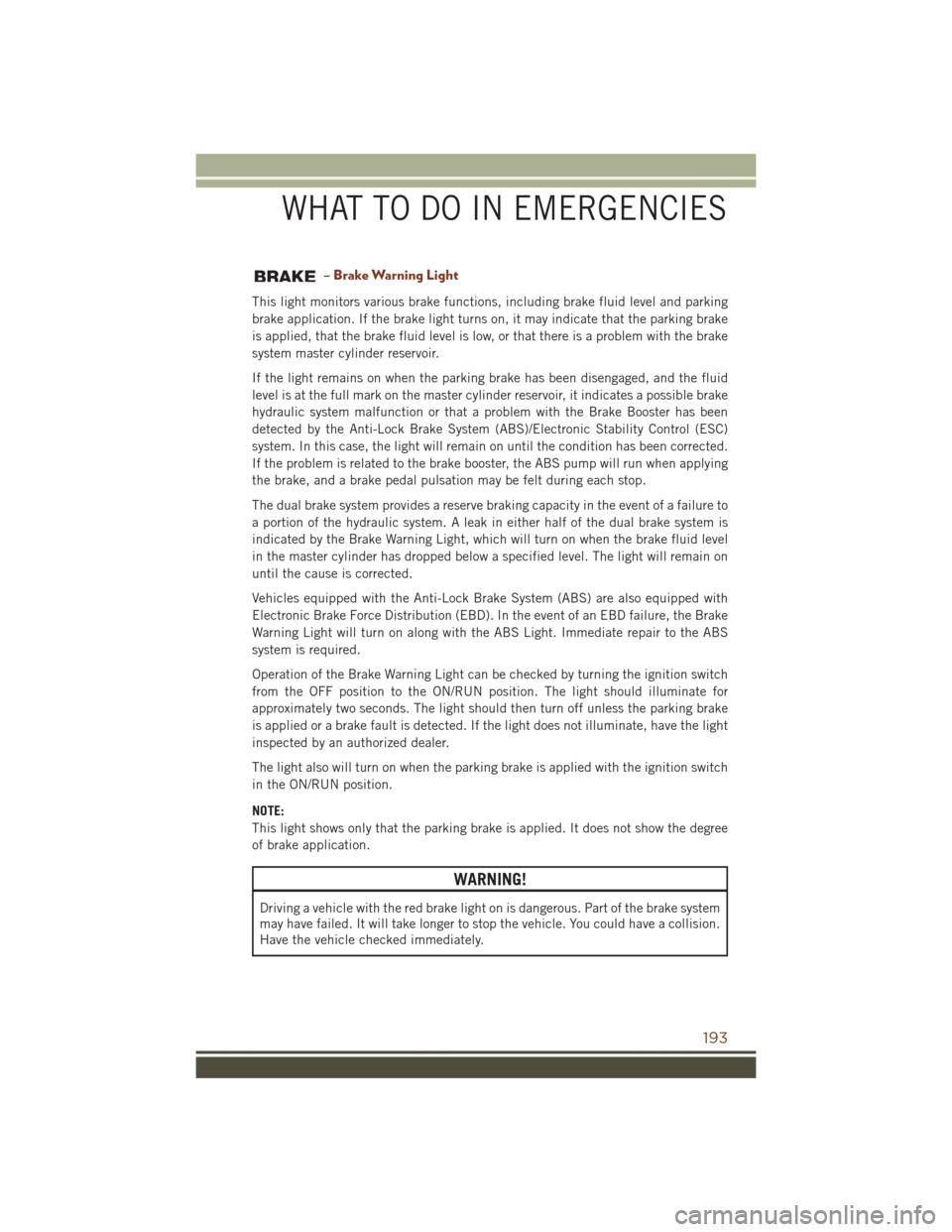
– Brake Warning Light
This light monitors various brake functions, including brake fluid level and parking
brake application. If the brake light turns on, it may indicate that the parking brake
is applied, that the brake fluid level is low, or that there is a problem with the brake
system master cylinder reservoir.
If the light remains on when the parking brake has been disengaged, and the fluid
level is at the full mark on the master cylinder reservoir, it indicates a possible brake
hydraulic system malfunction or that a problem with the Brake Booster has been
detected by the Anti-Lock Brake System (ABS)/Electronic Stability Control (ESC)
system. In this case, the light will remain on until the condition has been corrected.
If the problem is related to the brake booster, the ABS pump will run when applying
the brake, and a brake pedal pulsation may be felt during each stop.
The dual brake system provides a reserve braking capacity in the event of a failure to
a portion of the hydraulic system. A leak in either half of the dual brake system is
indicated by the Brake Warning Light, which will turn on when the brake fluid level
in the master cylinder has dropped below a specified level. The light will remain on
until the cause is corrected.
Vehicles equipped with the Anti-Lock Brake System (ABS) are also equipped with
Electronic Brake Force Distribution (EBD). In the event of an EBD failure, the Brake
Warning Light will turn on along with the ABS Light. Immediate repair to the ABS
system is required.
Operation of the Brake Warning Light can be checked by turning the ignition switch
from the OFF position to the ON/RUN position. The light should illuminate for
approximately two seconds. The light should then turn off unless the parking brake
is applied or a brake fault is detected. If the light does not illuminate, have the light
inspected by an authorized dealer.
The light also will turn on when the parking brake is applied with the ignition switch
in the ON/RUN position.
NOTE:
This light shows only that the parking brake is applied. It does not show the degree
of brake application.
WARNING!
Driving a vehicle with the red brake light on is dangerous. Part of the brake system
may have failed. It will take longer to stop the vehicle. You could have a collision.
Have the vehicle checked immediately.
WHAT TO DO IN EMERGENCIES
193
Page 198 of 276
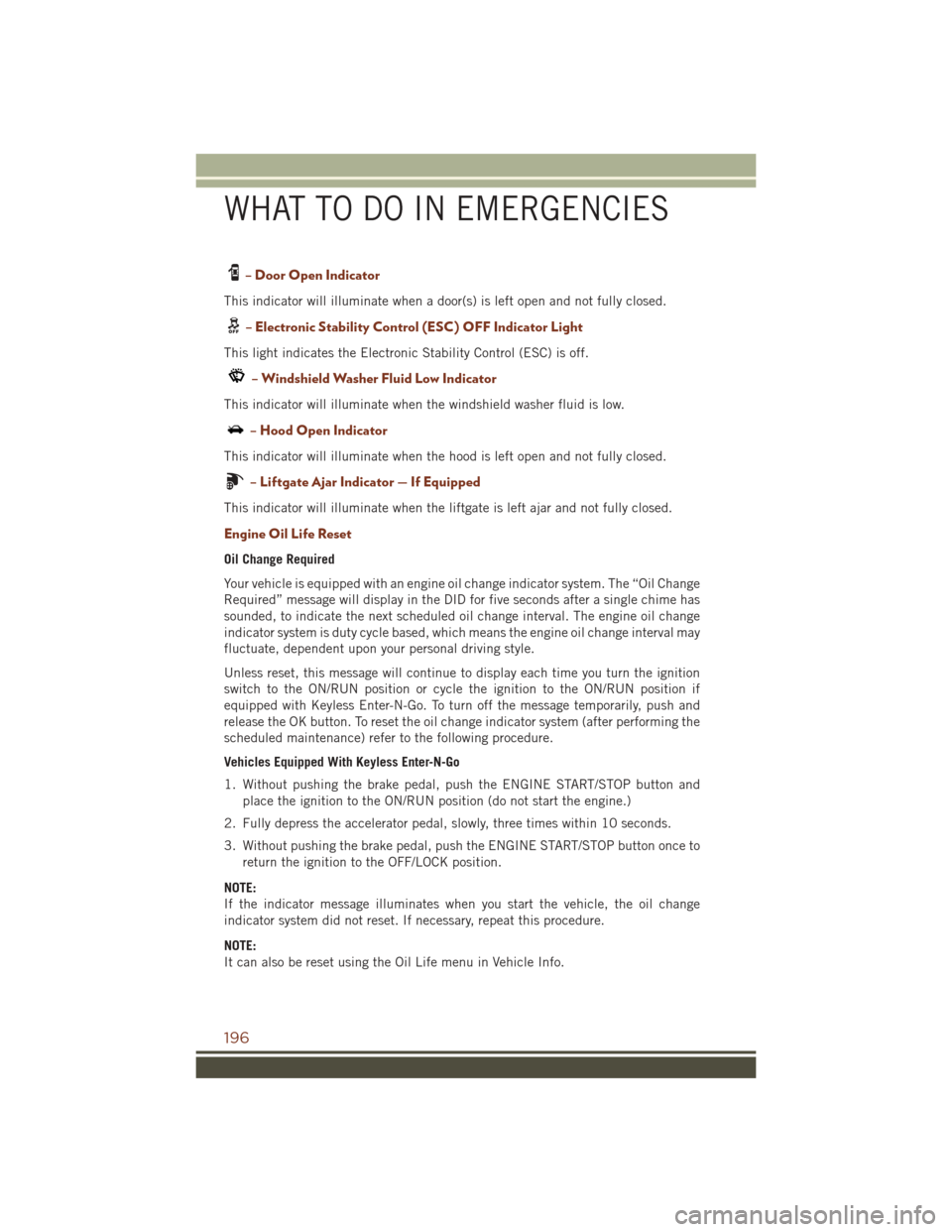
– Door Open Indicator
This indicator will illuminate when a door(s) is left open and not fully closed.
– Electronic Stability Control (ESC) OFF Indicator Light
This light indicates the Electronic Stability Control (ESC) is off.
– Windshield Washer Fluid Low Indicator
This indicator will illuminate when the windshield washer fluid is low.
– Hood Open Indicator
This indicator will illuminate when the hood is left open and not fully closed.
– Liftgate Ajar Indicator — If Equipped
This indicator will illuminate when the liftgate is left ajar and not fully closed.
Engine Oil Life Reset
Oil Change Required
Your vehicle is equipped with an engine oil change indicator system. The “Oil Change
Required” message will display in the DID for five seconds after a single chime has
sounded, to indicate the next scheduled oil change interval. The engine oil change
indicator system is duty cycle based, which means the engine oil change interval may
fluctuate, dependent upon your personal driving style.
Unless reset, this message will continue to display each time you turn the ignition
switch to the ON/RUN position or cycle the ignition to the ON/RUN position if
equipped with Keyless Enter-N-Go. To turn off the message temporarily, push and
release the OK button. To reset the oil change indicator system (after performing the
scheduled maintenance) refer to the following procedure.
Vehicles Equipped With Keyless Enter-N-Go
1. Without pushing the brake pedal, push the ENGINE START/STOP button andplace the ignition to the ON/RUN position (do not start the engine.)
2. Fully depress the accelerator pedal, slowly, three times within 10 seconds.
3. Without pushing the brake pedal, push the ENGINE START/STOP button once to return the ignition to the OFF/LOCK position.
NOTE:
If the indicator message illuminates when you start the vehicle, the oil change
indicator system did not reset. If necessary, repeat this procedure.
NOTE:
It can also be reset using the Oil Life menu in Vehicle Info.
WHAT TO DO IN EMERGENCIES
196
Page 221 of 276
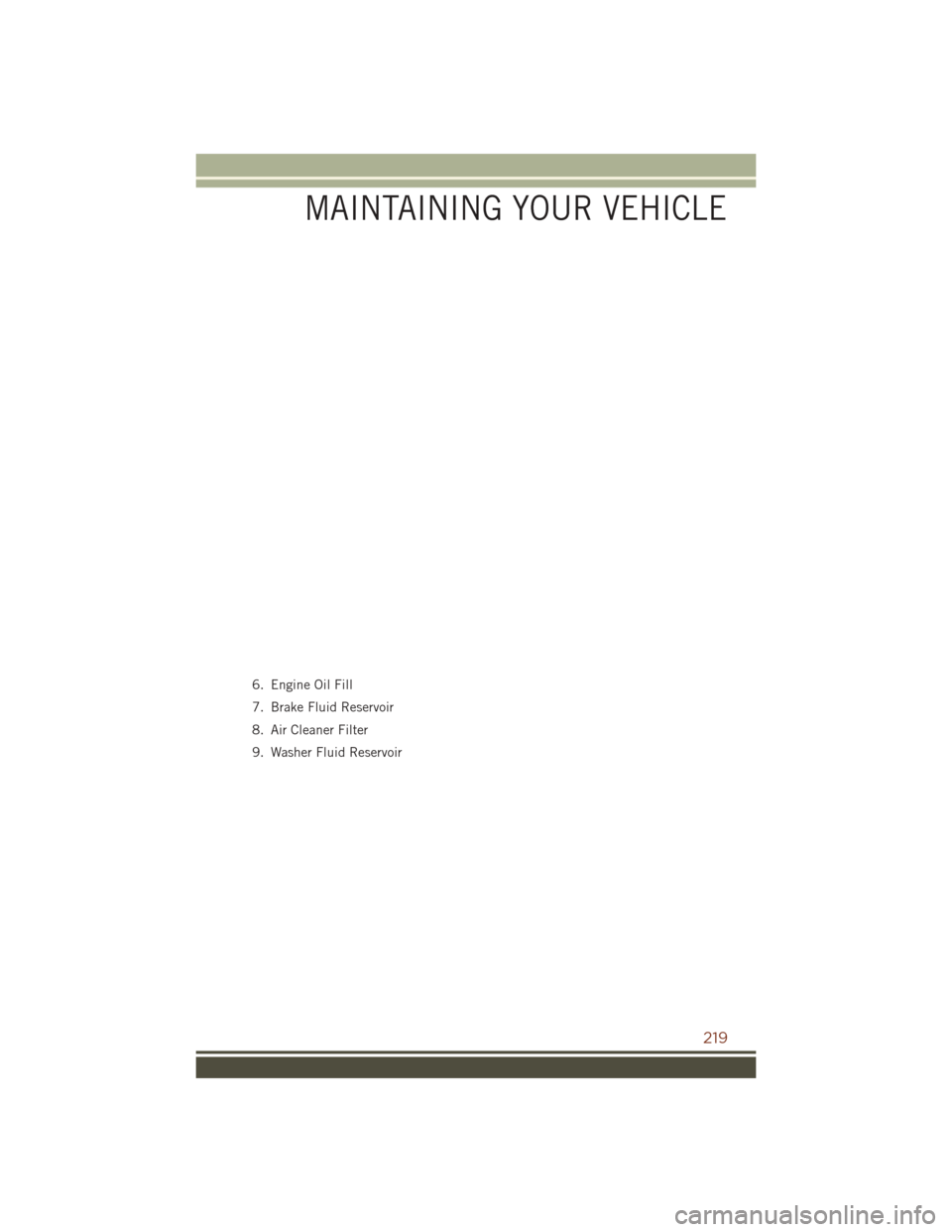
6. Engine Oil Fill
7. Brake Fluid Reservoir
8. Air Cleaner Filter
9. Washer Fluid Reservoir
MAINTAINING YOUR VEHICLE
219
Page 223 of 276
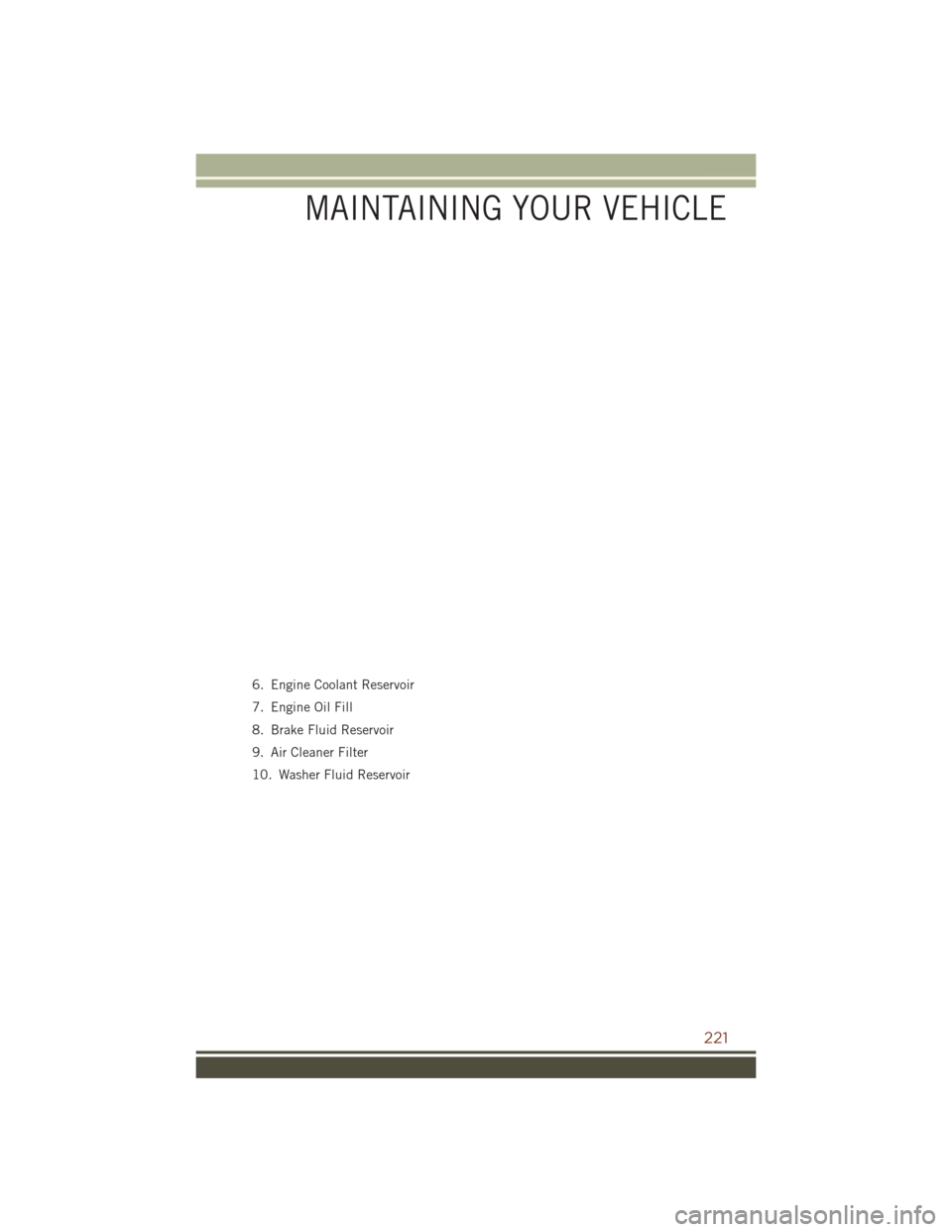
6. Engine Coolant Reservoir
7. Engine Oil Fill
8. Brake Fluid Reservoir
9. Air Cleaner Filter
10. Washer Fluid Reservoir
MAINTAINING YOUR VEHICLE
221
Page 225 of 276
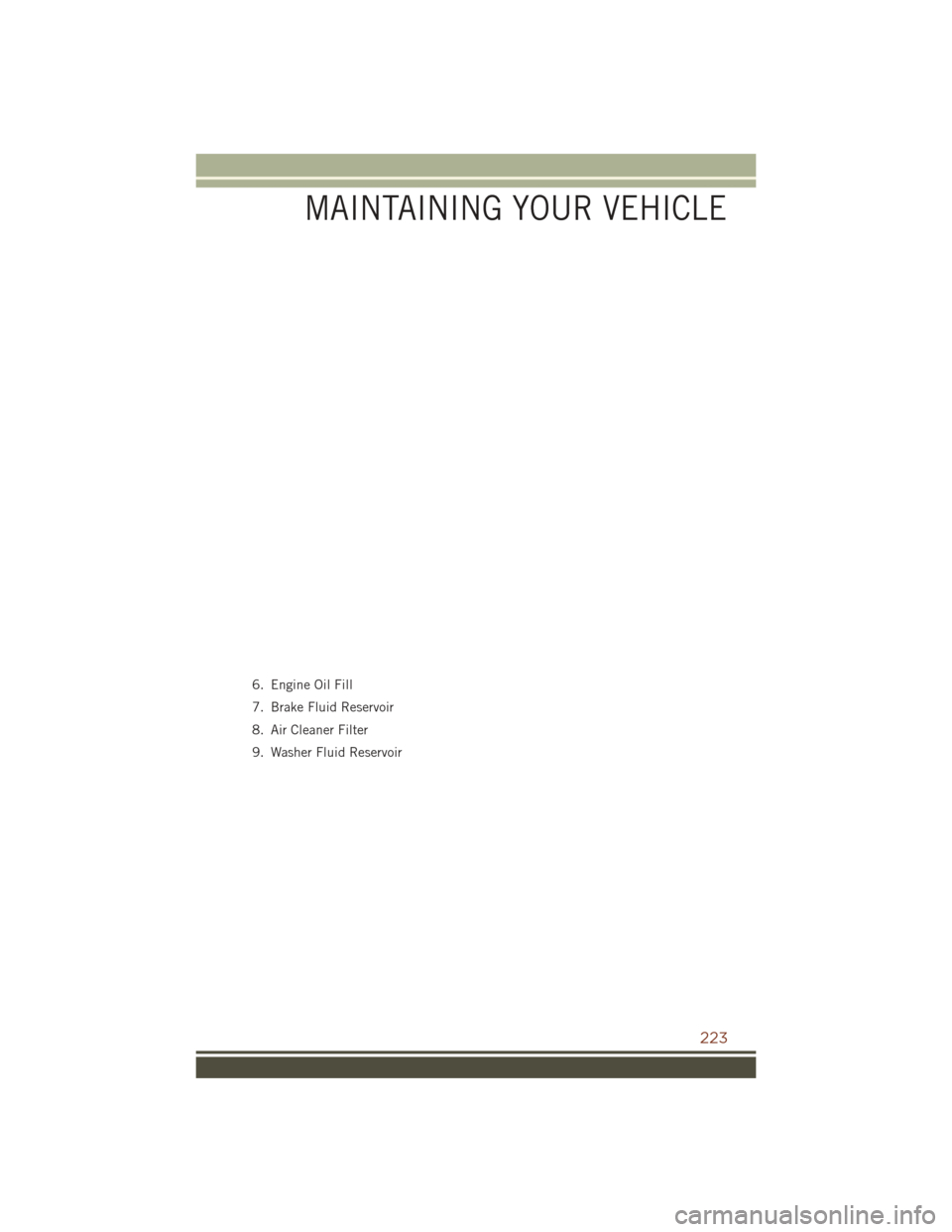
6. Engine Oil Fill
7. Brake Fluid Reservoir
8. Air Cleaner Filter
9. Washer Fluid Reservoir
MAINTAINING YOUR VEHICLE
223
Page 227 of 276
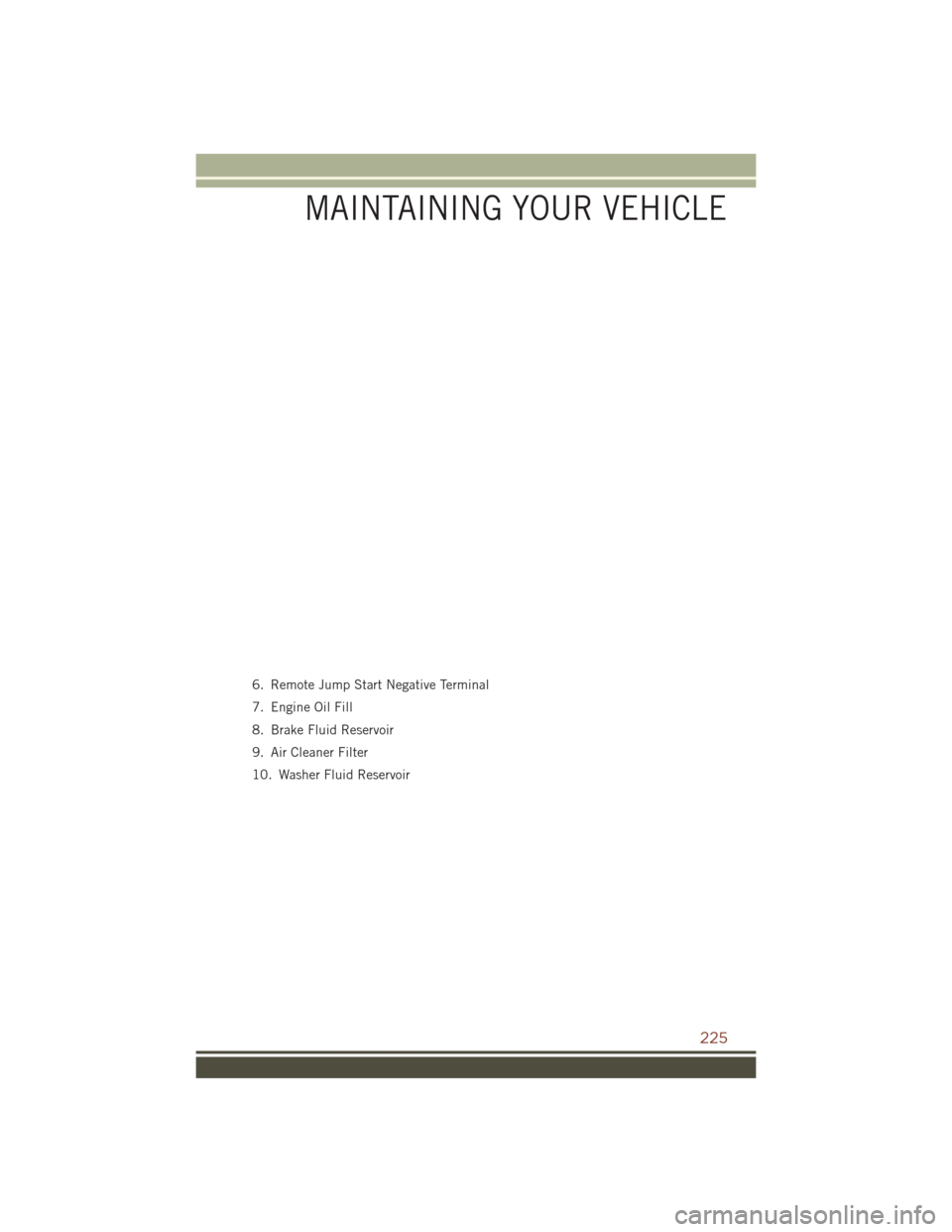
6. Remote Jump Start Negative Terminal
7. Engine Oil Fill
8. Brake Fluid Reservoir
9. Air Cleaner Filter
10. Washer Fluid Reservoir
MAINTAINING YOUR VEHICLE
225
Page 230 of 276
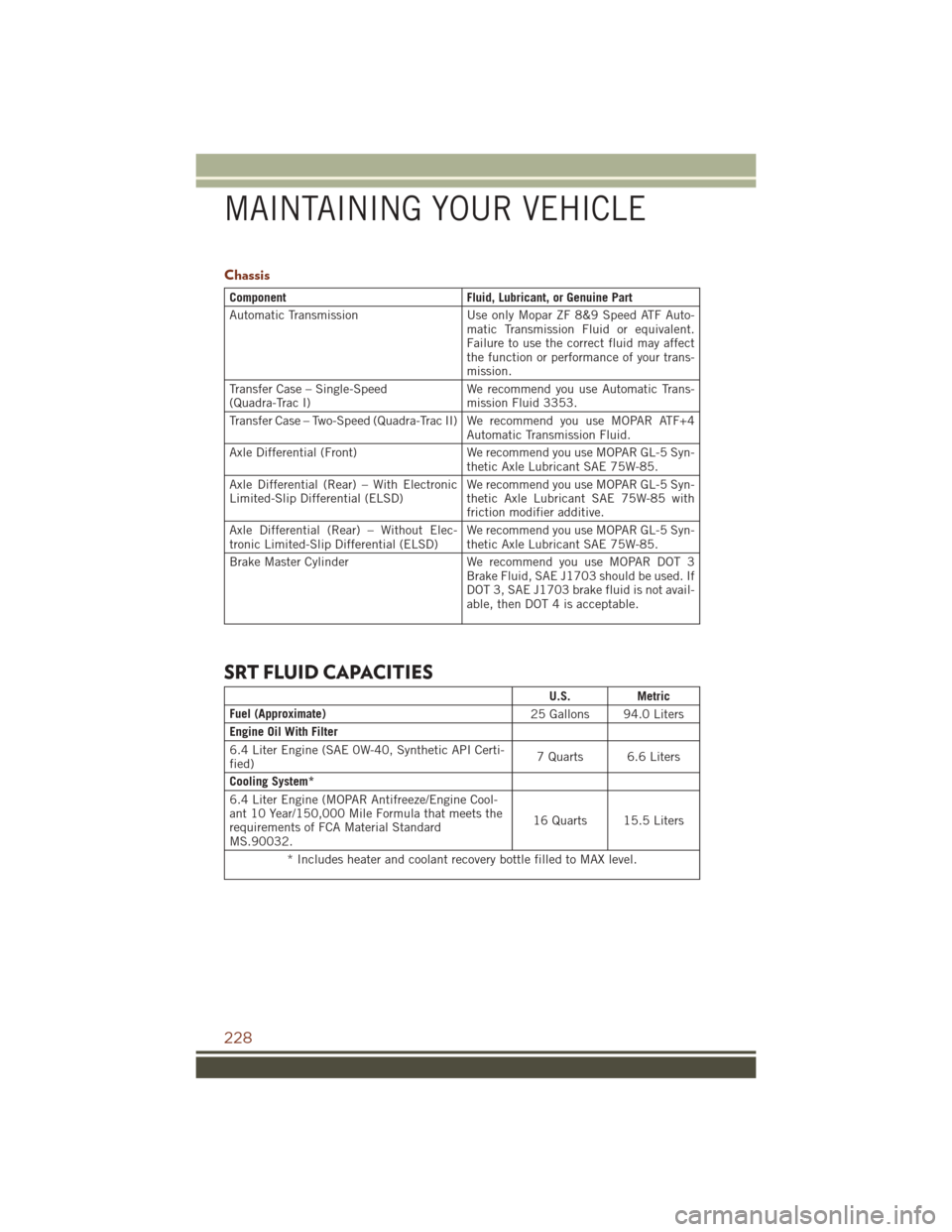
Chassis
ComponentFluid, Lubricant, or Genuine Part
Automatic Transmission Use only Mopar ZF 8&9 Speed ATF Auto-
matic Transmission Fluid or equivalent.
Failure to use the correct fluid may affect
the function or performance of your trans-
mission.
Transfer Case – Single-Speed
(Quadra-Trac I) We recommend you use Automatic Trans-
mission Fluid 3353.
Transfer Case – Two-Speed (Quadra-Trac II) We recommend you use MOPAR ATF+4 Automatic Transmission Fluid.
Axle Differential (Front) We recommend you use MOPAR GL-5 Syn-
thetic Axle Lubricant SAE 75W-85.
Axle Differential (Rear) – With Electronic
Limited-Slip Differential (ELSD) We recommend you use MOPAR GL-5 Syn-
thetic Axle Lubricant SAE 75W-85 with
friction modifier additive.
Axle Differential (Rear) – Without Elec-
tronic Limited-Slip Differential (ELSD) We recommend you use MOPAR GL-5 Syn-
thetic Axle Lubricant SAE 75W-85.
Brake Master Cylinder We recommend you use MOPAR DOT 3
Brake Fluid, SAE J1703 should be used. If
DOT 3, SAE J1703 brake fluid is not avail-
able, then DOT 4 is acceptable.
SRT FLUID CAPACITIES
U.S. Metric
Fuel (Approximate) 25 Gallons 94.0 Liters
Engine Oil With Filter
6.4 Liter Engine (SAE 0W-40, Synthetic API Certi-
fied) 7 Quarts 6.6 Liters
Cooling System*
6.4 Liter Engine (MOPAR Antifreeze/Engine Cool-
ant 10 Year/150,000 Mile Formula that meets the
requirements of FCA Material Standard
MS.90032. 16 Quarts 15.5 Liters
* Includes heater and coolant recovery bottle filled to MAX level.
MAINTAINING YOUR VEHICLE
228
Page 231 of 276
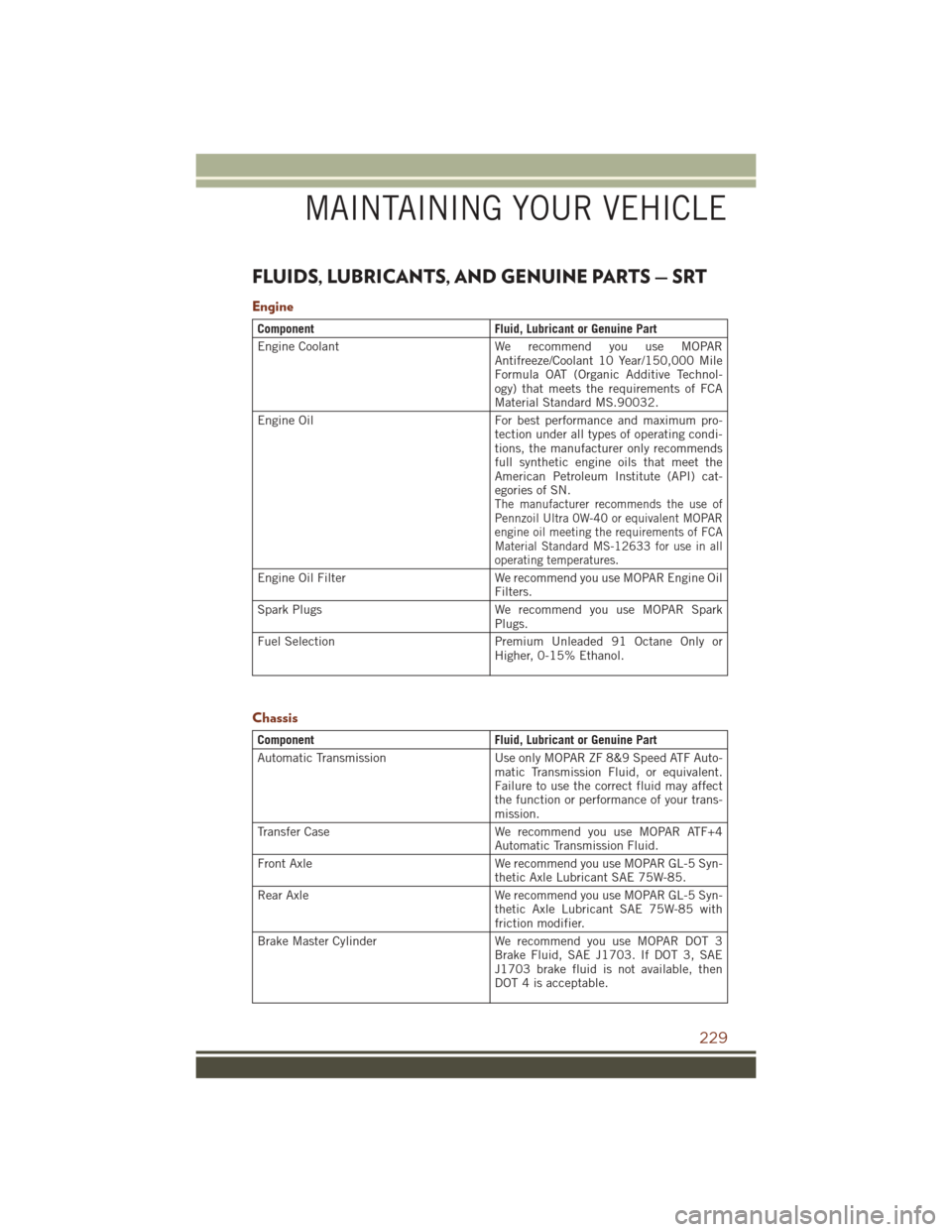
FLUIDS, LUBRICANTS, AND GENUINE PARTS — SRT
Engine
ComponentFluid, Lubricant or Genuine Part
Engine Coolant We recommend you use MOPAR
Antifreeze/Coolant 10 Year/150,000 Mile
Formula OAT (Organic Additive Technol-
ogy) that meets the requirements of FCA
Material Standard MS.90032.
Engine Oil For best performance and maximum pro-
tection under all types of operating condi-
tions, the manufacturer only recommends
full synthetic engine oils that meet the
American Petroleum Institute (API) cat-
egories of SN.
The manufacturer recommends the use of
Pennzoil Ultra 0W-40 or equivalent MOPAR
engine oil meeting the requirements of FCA
Material Standard MS-12633 for use in all
operating temperatures.
Engine Oil FilterWe recommend you use MOPAR Engine Oil
Filters.
Spark Plugs We recommend you use MOPAR Spark
Plugs.
Fuel Selection Premium Unleaded 91 Octane Only or
Higher, 0-15% Ethanol.
Chassis
ComponentFluid, Lubricant or Genuine Part
Automatic Transmission Use only MOPAR ZF 8&9 Speed ATF Auto-
matic Transmission Fluid, or equivalent.
Failure to use the correct fluid may affect
the function or performance of your trans-
mission.
Transfer Case We recommend you use MOPAR ATF+4
Automatic Transmission Fluid.
Front Axle We recommend you use MOPAR GL-5 Syn-
thetic Axle Lubricant SAE 75W-85.
Rear Axle We recommend you use MOPAR GL-5 Syn-
thetic Axle Lubricant SAE 75W-85 with
friction modifier.
Brake Master Cylinder We recommend you use MOPAR DOT 3
Brake Fluid, SAE J1703. If DOT 3, SAE
J1703 brake fluid is not available, then
DOT 4 is acceptable.
MAINTAINING YOUR VEHICLE
229
Page 234 of 276
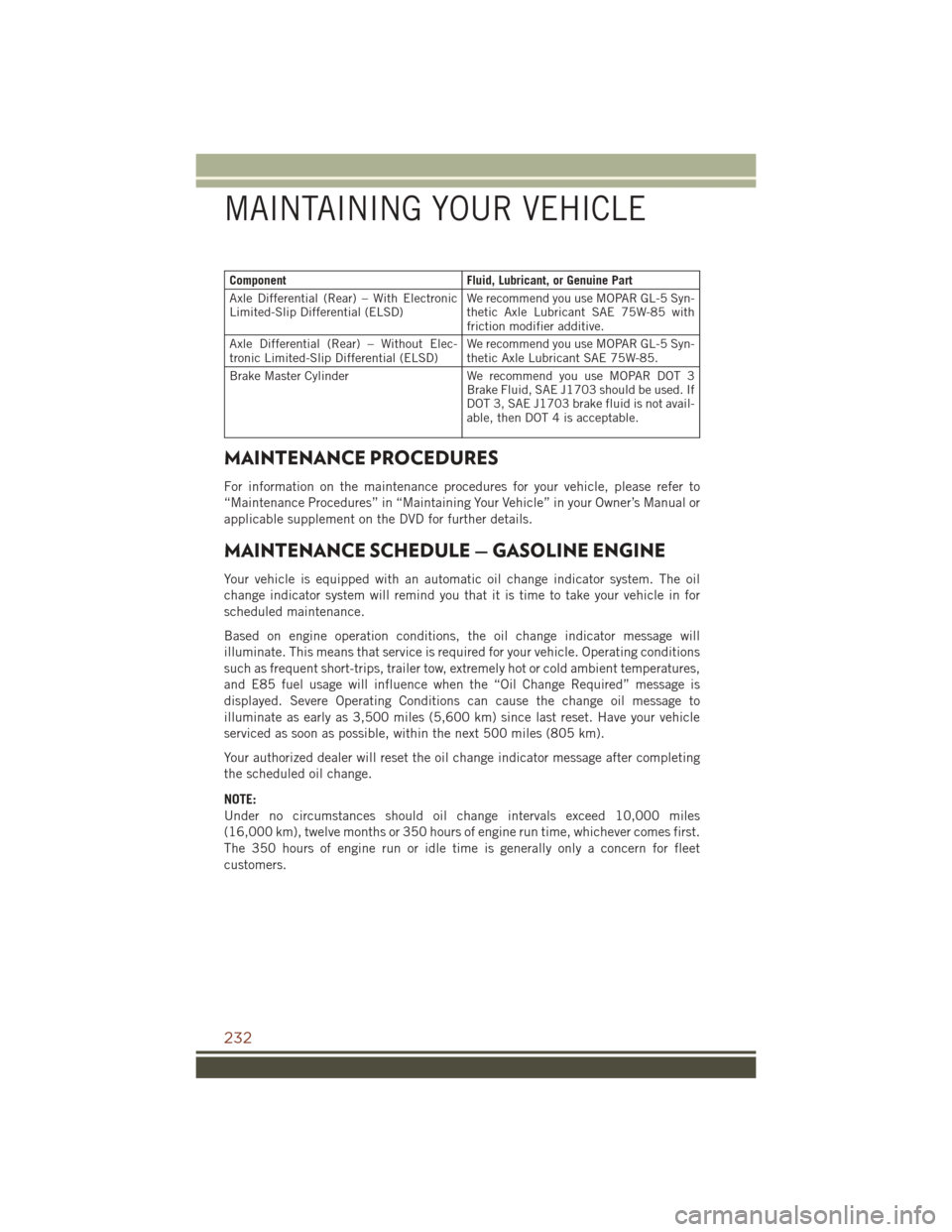
ComponentFluid, Lubricant, or Genuine Part
Axle Differential (Rear) – With Electronic
Limited-Slip Differential (ELSD) We recommend you use MOPAR GL-5 Syn-
thetic Axle Lubricant SAE 75W-85 with
friction modifier additive.
Axle Differential (Rear) – Without Elec-
tronic Limited-Slip Differential (ELSD) We recommend you use MOPAR GL-5 Syn-
thetic Axle Lubricant SAE 75W-85.
Brake Master Cylinder We recommend you use MOPAR DOT 3
Brake Fluid, SAE J1703 should be used. If
DOT 3, SAE J1703 brake fluid is not avail-
able, then DOT 4 is acceptable.
MAINTENANCE PROCEDURES
For information on the maintenance procedures for your vehicle, please refer to
“Maintenance Procedures” in “Maintaining Your Vehicle” in your Owner’s Manual or
applicable supplement on the DVD for further details.
MAINTENANCE SCHEDULE — GASOLINE ENGINE
Your vehicle is equipped with an automatic oil change indicator system. The oil
change indicator system will remind you that it is time to take your vehicle in for
scheduled maintenance.
Based on engine operation conditions, the oil change indicator message will
illuminate. This means that service is required for your vehicle. Operating conditions
such as frequent short-trips, trailer tow, extremely hot or cold ambient temperatures,
and E85 fuel usage will influence when the “Oil Change Required” message is
displayed. Severe Operating Conditions can cause the change oil message to
illuminate as early as 3,500 miles (5,600 km) since last reset. Have your vehicle
serviced as soon as possible, within the next 500 miles (805 km).
Your authorized dealer will reset the oil change indicator message after completing
the scheduled oil change.
NOTE:
Under no circumstances should oil change intervals exceed 10,000 miles
(16,000 km), twelve months or 350 hours of engine run time, whichever comes first.
The 350 hours of engine run or idle time is generally only a concern for fleet
customers.
MAINTAINING YOUR VEHICLE
232